July 2025 Yellow-Legged Hornet Update: Recent Removal Alert and Primary Nests
Our goal is to keep you informed about the Yellow-Legged Hornet (YLH) infestation in South Carolina. Supportive community relationships are essential to the success of detecting, tracking, and removing this pest. This update is being issued to collaborators, communities, and stakeholders, and we invite you to share this information with anyone who may be affected by our operations.

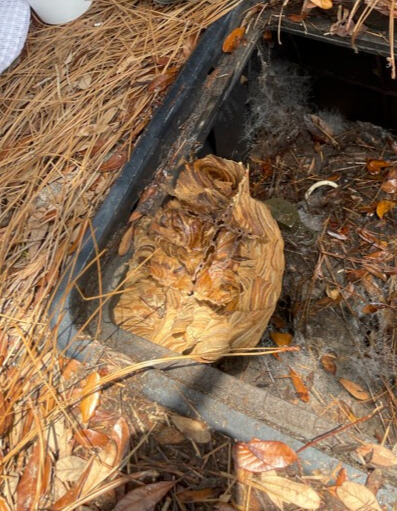
Photo description: Several recent YLH nests have been discovered in unique locations. These locations include a water meter box in the ground.
Background
What happened? In August 2023, Vespa velutina, Yellow-Legged Hornet (YLH) was detected in the United States for the first time near Savannah, GA, less than five miles from the South Carolina-Georgia border. In Spring 2024, several YLH queens and one embryo nest were found in Beaufort County; worker detections continued through summer.
Why do we care? Yellow-Legged Hornets prey on honeybees, causing reduced foraging and colony failure. This impact would result in reduced honey and other honeybee products and reduced crop production due to decreased pollination by honeybees and native pollinators.
What are we doing? With the Support of USDA APHIS, Clemson’s Honeybee Protection Program surveys for YLH focuses on detecting workers and finding nests within a wide area around the initial detection. Baited traps are used to initially detect hornets, followed by tracking live hornets to narrow down the nest search area. Eradication of this species focuses on locating and destroying nests and eliminating queens. Nests should ideally be located and destroyed by late summer or very early fall before new queens are actively mating and dispersing, and nest destruction should continue throughout the fall and early winter. From mid-summer through the end of 2024, Clemson’s Honeybee Protection Program found 16 YLH nests and removed or destroyed 15 of those nests. In 2025, the 16th nest detected was removed. Currently in 2025 there have been 10 Embryo nests, 9 Primary nests, and 2 secondary nests located and removed. There are presently 1,147 YLH traps being monitored. 375 YLH Queens and 510 YLH adults were caught and removed from the environment due to trapping efforts this past Spring. Several nests have been reported through Clemson Department of Plant Industry’s reporting tool, found at clemson.edu/ylh. Public engagement has been critical for many successful nest removals in 2025.
What does it look like?
- Body length:
- Ranges from 0.7 – 1.0 inches
- Colorations:
- Head: Mostly black with some front-facing yellow/orange; Black eyes
- Thorax: Mostly solid black/dark brown
- Abdomen: Alternating bands of dark brown/black and yellow/orange
- Legs: Brown or black near the body, ending in yellow segments

Photo credit: Guillame Souvan/AFP/Getty Images
Latest Buzz
The Clemson Department of Plant Industry (DPI) inspectors and USDA personnel in South Carolina have Yellow-Legged hornet traps placed throughout Beaufort County, Jasper County, Colleton County, Charleston County, and Hampton County of South Carolina. These traps are monitored regularly for YLH activity. The locations have been established in the South Carolina Lowcountry near known YLH detections and, where possible, near known honeybee colonies.
During the Spring season the YLH Queen emerges from overwintering. Early detection of the first stage of nest called an “Embryo Nest” is critical in preventing the third and final stage called a “Secondary Nest”. During this time the queen constructs the nest in which she rears the first set of workers.
DPI is currently catching workers which means any YLH nests have now switched from the Embryo nest stage to the Primary nest stage. Primary nests are built by worker Yellow-Legged hornets. These nests will vary in size from the of a softball to a basketball. Nesting sites typically are found in a protected area that is sheltered from environmental conditions, often constructed in bushes or trees. Some examples are outdoor structures underneath roof lines and eaves of buildings. Other examples are in bushes and trees ranging in height from six feet off the ground to 25 feet.
Several recent YLH nests have been discovered in unique locations. These locations include a water meter box in the ground and several nests inside the rooflines of structures.
If you believe you have identified a primary nest, do not attempt to remove it yourself. Please report at the Clemson® DPI’s reporting tool.
Beekeepers and the public located in the Lowcountry of South Carolina need to stay vigilant and report YLH using the reporting tool. Reporting is very important to slowing the spread of YLH. Beekeepers please monitor your apiaries and report YLH Hawking.




Please DO NOT attempt to remove a primary nest on your own. Report it to the YLH Reporting Tool. Someone from the YLH Response Team will contact you and arrange the removal. We will make sure to remove the nest and queen, this will ensure the queen does not fly off and start a new nest location.

YLH By the Numbers – 2025 YLH stats as of 07/14/2025
- 1,147 traps set in Beaufort County, Jasper County, Colleton County, Charleston County, and Hampton County
- 6,705 YLH trap services completed in Beaufort County, Jasper County, Colleton County, Charleston County, and Hampton County
- 375 YLH Queens have been caught and removed from the SC environment
- 510 YLH adults have been caught and removed from the SC environment
For 2024 YLH data, check out a previous edition of the Hornet Herald, linked here.
YLH Mapping: Queens & Nests
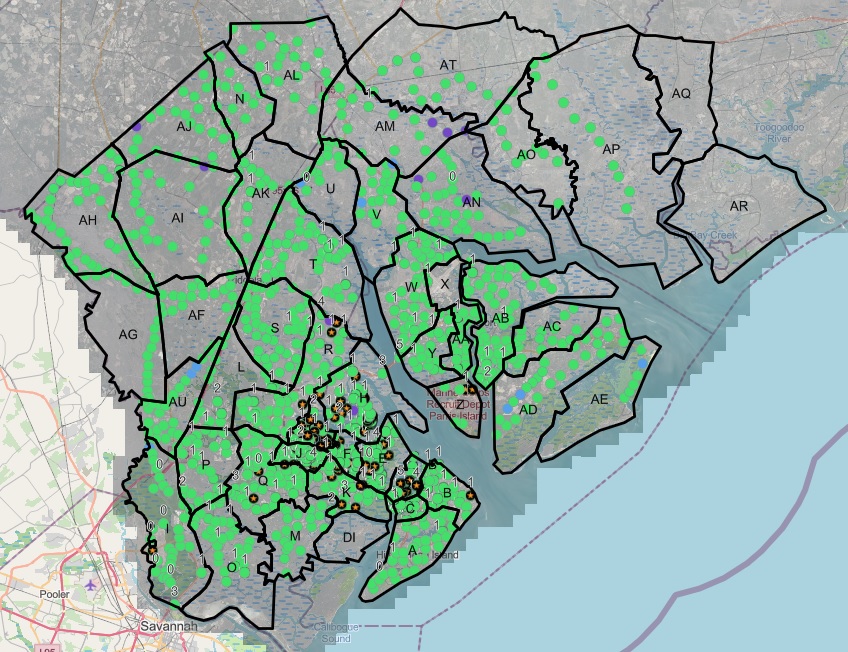

The above map is the current YLH Survey response area.
The above map reflects YLH nests located and removed in 2024-25. To view the live map, please follow this link to Clemson® DPI’s GIS map of known YLH nest locations in South Carolina.
What You Can Do
- Beekeepers: Beekeepers play a vital role in monitoring apiaries and colonies for YLH activity and reporting YLH sightings to Clemson® DPI’s reporting tool. Reporting activity helps DPI deploy traps if needed and attempt to identify the nest location in a timely manner.
- Citizens: All South Carolina citizens can familiarize themselves with hornet and nest identification and assist with reporting. A citizen trapping program for the YLH is now live. The program includes instructions & videos (see below) on constructing traps, baits, and reporting YLH findings.
- ALL REPORTS ARE REQUIRED TO SUBMIT A PHOTO WITH THE REPORT. AN IDENTIFICATION CANNOT BE MADE OR VERIFIED WITHOUT A PHOTO.
YLH Life Cycle
Additionally, South Carolina citizens can familiarize themselves with the YLH lifecycle to assist with year-round identification. By recognizing the YLH in different life stages, and understanding the different nests constructed throughout the YLH lifecycle, citizens can assist in the early detection and eradication of YLH infestations.
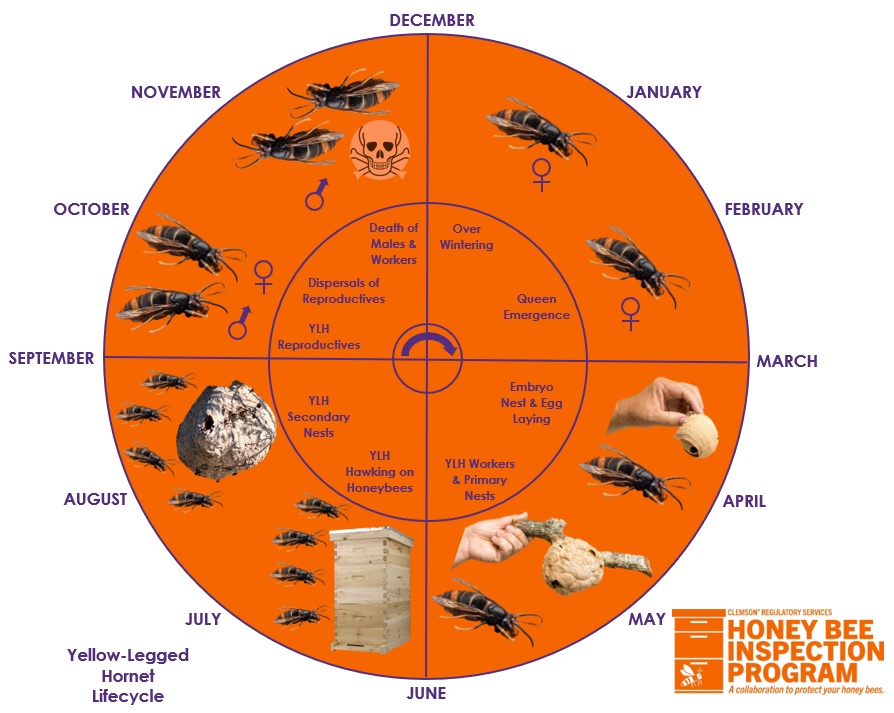
YLH Primary nests are beginning to expand as more YLH workers emerge and take on nest construction and expansion. We are encouraging people that live in the Lowcountry of South Carolina to inspect all outdoor structures for any YLH activity and report any findings to the YLH Reporting Tool. A property inspection should also include reporting any nests found in trees or shrubs. Beekeepers are still encouraged to report any hawking behavior. Please be patient for a follow up to any report, there has been an increase in reporting.
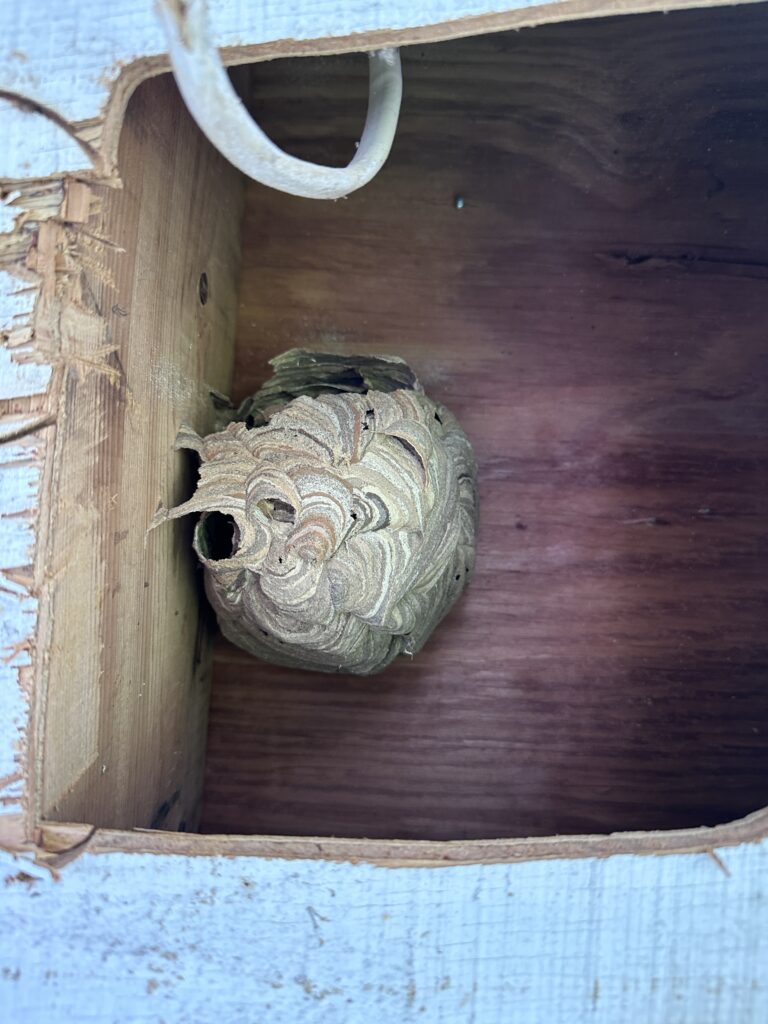
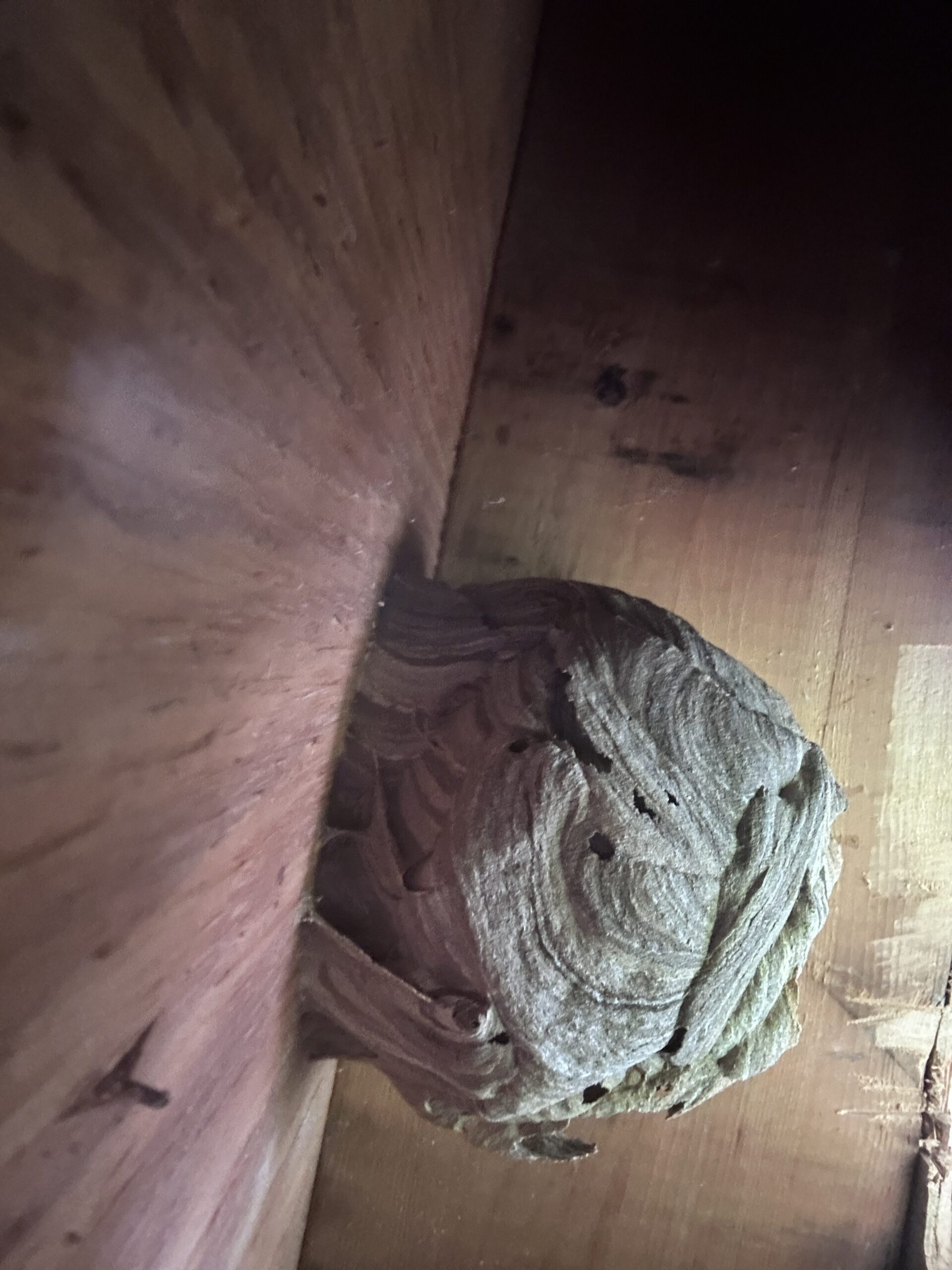
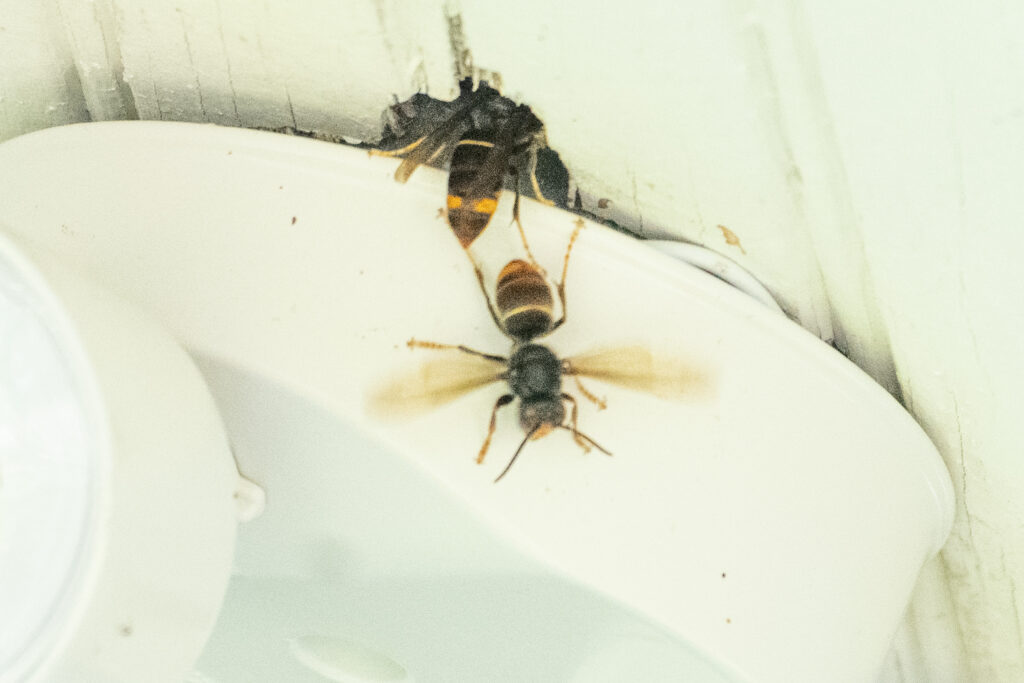
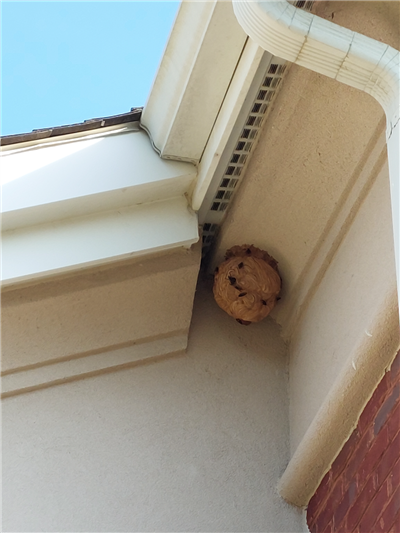
Closing
The mission of Clemson University Department of Plant Industry (DPI) is to protect South Carolina’s agricultural resources and natural ecosystems from the introduction and spread of invasive species and to enhance the efficiency of South Carolina’s agriculture. South Carolina faces major concerns from biosecurity issues and exotic pests. Without federal assistance, South Carolina would not be able to maintain early detection, provide maximum affordable laboratory capability, and maintain a field force to conduct surveys. Furthermore, the identification, quarantine, and disposal of introduced pests at effective levels would not be possible.
Clemson DPI would like to recognize the funding and support received from the USDA, without which YLH trapping efforts would not be possible. We would also like to thank the Georgia Department of Agriculture for their invaluable expertise and collaboration on YLH eradication in South Carolina.
Helpful Links
- Clemson® DPI Resources
- USDA APHIS on YLH
- Georgia Department of Agriculture on YLH
- Clemson Extension’s Apiculture and Pollinator Program
- Article on Exotic Hornet Threats to Apiculture
Want to stay in the loop?
Tune in for our monthly newsletter! Get the newsletter to your inbox each month. To subscribe scan this QR code, visit this link, or follow the instructions below:

1. Create a new email message to listserv@lists.clemson.edu
2. In the body of the message, type the following: subscribe listname First Last
Example: subscribe SCYLHNEWSLETTER Jane Doe
3. If there is an email signature in the body of the message, you must remove it so it does not interfere with Listserv reading the subscription command.
4. Send the email.
5. Subscriber should receive an email confirmation it was successful.
